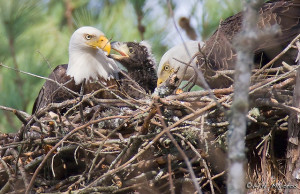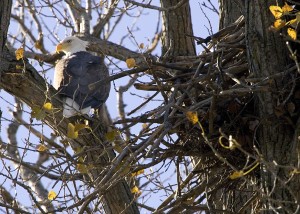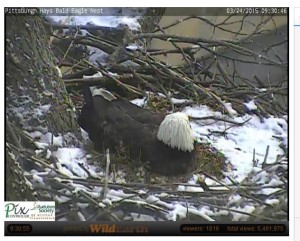It is amazing that we can now refer to the bald eagle as one of “our birds” here in western Pennsylvania! In the early 1980’s when I moved here it was possible to find bald eagles (mostly up around Lake Erie) but they were very uncommon. In the past 5 or 6 years, though, mating pairs, year round residents, and overwintering groups have all been seen with great regularity all around our area!
I live in Kiski Township in southern Armstrong County and have seen bald eagles flying over my house, flying over the road on my drive to and from campus, and have heard them when I ride my bike down on the Roaring Run Trail. The drive over the Freeport Bridge almost always affords a good look at a bald eagle (or two) soaring over the Allegheny River, and last November Deborah and I spotted a perched eagle next to the Kiski River right across the street from the North Apollo Sunoco Station! They are becoming quite a regular occurrence (but are still a challenge to safe driving whenever they show up!).
Bald eagles were once a relatively common species in North America. Prior to European colonization it is estimated that there were 500,000 bald eagles in North America (about 7 times the number we have now). Every large river and lake had their resident eagles. By the early 1960’s, though, there were only 450 nesting pairs of bald eagles left in the lower 48 states!
The decimation of this species was due to multiple factors: habitat destruction, human encroachment, hunting, and ultimately the impacts of environmental pollutants (especially pesticides) on their reproductive physiology. But legislation and vigorous protection of bald eagles (via the 1940 “Bald Eagle Act” and its designation as an endangered species in 1967) has led to the resurgence of the species. There are now over 7,000 nesting pairs of bald eagles in the lower 48 states. In Pennsylvania there are 266 nesting pairs of bald eagles (compared to just 3 pairs 30 years ago!).
Bald eagle nests are great masses of sticks usually wedged together high up in a tree or on a rock cliff but occasionally even gathered together on the ground. The shape of the nest is determined by the geometry of the substrate: if it is in a fork of a tree you see a conical (“cylindrical”) nest. If it is on some flat branches (or on a flat rock or flat ground) you see a disk shaped nest. There are also “bowl shaped nests” and “inverted cone nests” and it seems however the branches go together is just fine for the eagles.
The average diameter of a bald eagle nest is 5 feet, and a pair will use the same nest for as many years as it holds together adding sticks each year to the mass. The largest bald eagle nest (which was a very old, often used one) was 9 feet in diameter and 13 feet deep. It was made up of 1.1 tons of sticks! And this was the largest tree nest ever recorded for an animal species!
Most nests last about five years. Usually the eagles select the largest, tallest tree in their territory. A view out over the water is required! Eagles complete for both nest sites and also the actual nest with hawks, crows and ravens.
The mating season for bald eagles runs from January to March. The mating pair engages in a wild, tumbling clutching flight/free fall that involves them flying to great heights, clutching each other via their talons and falling rapidly toward the ground. They break their grip just before hitting the ground and pull up out of the dive. It must be an incredible experience to see one of these mating clutches in person!
Bald eagles mate for life, but an eagle will take a new mate if an old mate dies. Bald eagle pairs don’t breed every year. I am sure that food resources and overall health of the partners play a role in determining whether a clutch of eggs will be laid or not.
Eggs begin to be laid 5 to 10 days after copulation. One egg is laid and then a few days later another, and then possibly a few days later one more. There is a 35 day incubation period and both the male and the female take turns sitting on the eggs. It can be a very tense and sometimes awkward moment when one of the parents tries to oust the other from the eggs. The resulting tussle can actually damage the eggs and even lead to a whole nest failure.
Eggs hatch in the order that they were laid, and it can take 12 to 48 hours for the hatchling to peck its way out of its egg. During the emergence period and for a number of days afterwards the female stays exclusively on the nest and the male works to keep her fed.
Many birds have this sequential hatching pattern and like many of these other species if food is at all limiting (too little food in the area or too inexperienced or inefficient parents to gather sufficient food for the nestlings) the oldest nestling will kill the younger. This “sibicide” seems very cruel (especially if you are watching it on a nest camera!) but it is a very efficient way to make sure that at least one of the nestlings will get sufficient food to grow and fledge.
The parents bring the nestlings prey, and they initially shred the carcasses and feed the raw meat to the eaglets. Eaglets grow incredibly rapidly (and therefore require immense amounts of food!). Growth rates of a pound every 4 or 5 days are typical. This is the fastest growth rate of any American bird.
Development is also rapid: at two weeks the eaglets can hold up their heads, at 3 weeks they are 1 foot tall and have adult size feet and beaks, at 4 to 5 weeks they can stand up and also can start tearing up their own food, at 6 weeks they are as large as their parents, at 8 weeks they start exercising their wings, and at 10 to 13 weeks they fledge. About 40% of the eaglets do not survive their first flight! And a little over half of all eaglets do not survive their first year! (that first step out of the nest is a real doozy!).
The development of small, durable, weather-resistant cameras has enabled researchers to closely monitor the activities inside of an eagle’s nest. The connection of these cameras to an Internet stream has further opened up this incredibly intimate view of bald eagle egg incubation and nestling/fledgling nurturing to the general public.
I tried to search around the web to find out exactly how many of these eagle cams are currently operating, but I wasn’t able to get a broad US-wide or World-wide count. To say that there are hundreds of them is probably reasonable estimate. A very popular eagle cam in our area is the Hays Eagle Cam down on the Monongahela River about five miles upriver from the point at Pittsburgh. The establishment of this camera reflects the amazing recent history of the bald eagle in our area.
Bald eagles returned to the rivers near Pittsburgh in 2012 possibly for the first time in nearly 200 years! There was a nest along the Ohio River and although that pair did not successfully produced a fledging, the next year (2013) another pair of bald eagles nesting in a small, fragile tree near Hays along the Monongahela River did successfully fledge an eaglet! This was the first eaglet born and fledged along the three rivers of Pittsburgh in two centuries!
The 2013 Hays nest fell apart that summer. In 2014, though, a second pair of bald eagles moved into the site and built a very substantial nest in a tall tree nearby. In that same fall Bill Powers of Pix Controller Inc with the permission of the PA Game Commission set up a nest camera on a nearby tree. In 2014 millions of viewers tuned into the Hays Nest Cam and watched the eagle pair incubate, hatch, nurture and fledge three healthy eaglets
This spring there have been a nesting pair of bald eagles on the Ohio River, another on the Allegheny River near Harmerville, and the Hays pair on the Monongahela. All three of Pittsburgh’s rivers have reproducing bald eagles! Unfortunately, a couple of weeks ago the Hays pair abandoned the nest after their second egg failed. There is always next year, though!
The Three River Eagles are back!




